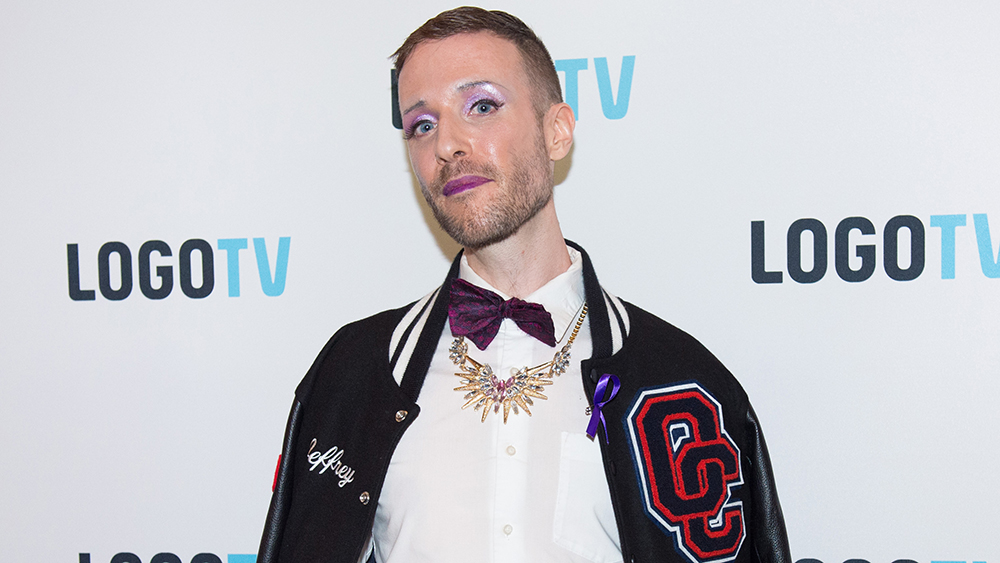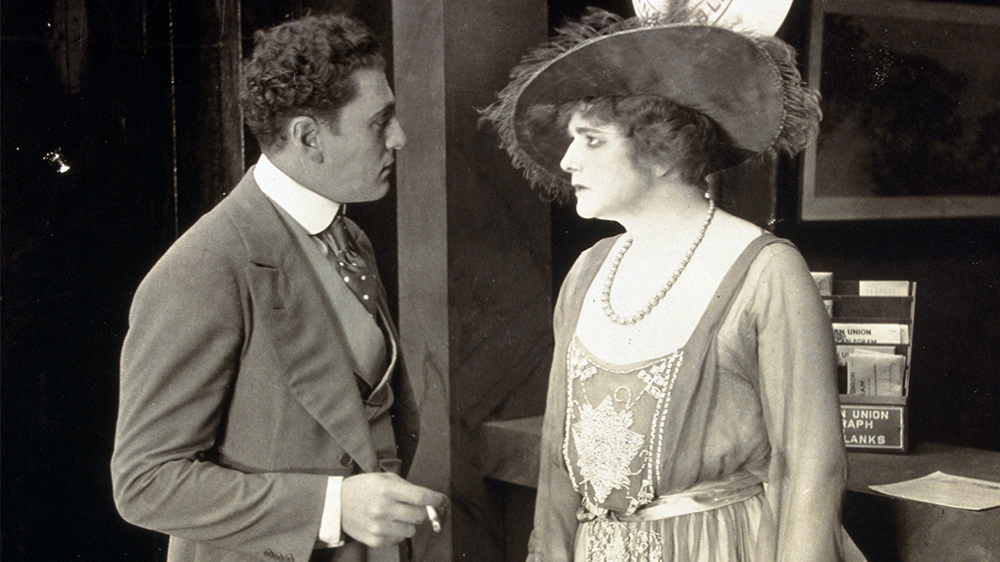How a Vaudeville Star Helped Pave the Way for Trans Representation
By Jeffrey Marsh
LOS ANGELES (Variety.com) – If you visit the AMC movie theater on 42nd street in New York, look up when you’re buying popcorn and Swedish fish. Above “The Spy Who Dumped Me” posters and automated ticket kiosks is one of the most glorious (and forgotten) pieces of trans film history. Dominating the lobby’s enormous vaulted ceiling is an original mural depicting three joyful and colorful life-sized ladies. They are the three muses: Lady Song, Lady Dance, and Lady Music. Their togas swirl as they twirl to the sounds of a Pan-like hoofed musician playing a flute nearby. What you may not realize, and what thousands of ticket buyers who pass through the lobby every year do not know, is that each lady is a portrait of William Dalton, whose stage name was Julian Eltinge.
Julian, born 1891, was a vaudeville and silent film actor praised by the Boston Globe as “the greatest of all impersonators of women” for his sensitive and grounded portrayals. Julian was the founder and impresario of the building AMC eventually purchased, once called the Eltinge theater. After building a namesake Broadway theater, Julian shifted focus to Hollywood and acted in several successful silent film farces of the early 20th century, often playing a leading man who is also a leading lady. Starring in “Madame Behave,” Julian is the dashing Jack Mitchell who helps a friend win a court case by eventually taking the stand as the titular Madame. (Spoiler alert: she won’t behave.)
Trans and gender non-conforming people like me have always been a part of Hollywood, and perhaps poetically, we have also always created our own opportunities and meticulously honed our careers and personas in the not always accepting public eye. Julian rose from a budding stage star/let to one of the highest-paid silent film performers, one who could insist scripts be written expressly for him. He often approved all aspects of a film’s production and costuming, from his dainty corsets to his manly cigars. Is Julian a gender-nonbinary film icon? Are Julian’s eyes — heavily lashed and smoky — flickering and fluttering on the silent screen, a window into trans film history?
It is hard to know whether labels like nonbinary and transgender accurately describe Julian. I use the gender-neutral pronoun “they.” What would Julian think of this pronoun? Would Julian use it? We can’t know. But one thing is for certain, many trans people working in the industry today embrace Julian’s legacy and take inspiration from his entrepreneurial spirit. I have carefully crafted my own career outside the mainstream of a TV and film industry that can misunderstand my identity.
Accounts vary, but according to one biographical source, Julian’s father beat him when he discovered Julian in a dress at around age 10. I can relate. When I was 11, my mom’s shoes stopped fitting. I remember putting them on when she was at work, and I can still feel the heavy dread and the clenching to stop the knots in my throat when I realized my growing feet had been stretching her shoes out — when I realized maybe she knew. My dad found out, and he had his own violent reaction. I’ve sat in a movie theater many times with that same dread and clench, watching a trans story told by a crew, cast and director who are not trans. It feels like, as trans people, if we were allowed to fully tell our own stories, we’d be too big and too honest and too raw. We would stretch Hollywood too much. Then I think about all of the gender blurring stars who have come before me.
I’m like Julian Eltinge and Bessie Bonehill the mega-rich Music Hall “male impersonator. I’m like Barbette, cinema’s greatest gender-blending trapeze artist who appeared in Joseph M. Newman’s “The Big Circus.” In 1913 Texas, he first trapezed in full makeup and wig at age 14. He swung with his friends; they were billed as “The Alfaretta Sisters.” I’m like Gladys Bentley, the mega-masculine jazz singing leader of the Harlem Renaissance who performed on “You Bet Your Life.” Her signature top hat and tux were as popular as her basement-low graveled baritone, and artist Romare Bearden once mistook her for a man trying to be a female impersonator. Like these pioneers, I have created my own frame big enough to hold all of my possibilities. Yes, the screen I’m on is the size of your phone, and yes it is in your pocket, but that intimacy eases your anxiety in receiving a fully open patch-work trans self. There are no footlights and no gatekeeping studio systems to come between us.
Marlene Dietrich, perhaps the most compelling film actor of Old Hollywood, was also androgynously playful with gender and jealously guarded about her image. She demanded there be a mirror on every set so that she could adjust lighting (and frame each shot) presaging the modern trend of the mirror selfie. With Marlene’s notorious attention to detail, we can assume that she would not have worn suits so often in public, or appeared in a full tuxedo and slowly kissed a woman co-star, like she did in Morocco, if she didn’t want to. The gender-fun social stars of today use monitors as mirrors, but they are just as meticulous about setting a frame and lighting up a narrative.
There is one difference between then and now — between old Hollywood’s self-made “impersonator” stars and our current viral video movement: today we are free enough to tell our own stories. Meredith Talusan’s inclusive and intersectional journalism urgently highlights our most important struggles for representation and acceptance. They are the editor of Condé Nast’s first LGBTQ publication: Them. Stef Sanjati has shared her deeply personal and touching transition story with the world and helps anyone craft an outward image that matches their heart through trans-friendly makeup tutorials. Author Ash Hardel uses YouTube as a gateway to helping trans people better understand themselves, but Ash also speaks directly to the moms and friends who need help knowing how to support our community. As a performance artist, Alok V. Menon uses their eclectic personal style and sharp societal commentary to challenge preconceived notions of gender and the commoditization of beauty.
As one of the creators of the TV show “Take My Wife,” Rhea Butcher makes stand-up comedy a vehicle for self-expression, pushing the boundaries of identity with brave and cutting humor. And Jacob Tobia’s brilliant and soaring trans-feminist writing and speaking opens and expands our representation. As a producer, they are re-shaping the TV and film industries toward inclusion with solo projects and their work with MSNBC.
And then there’s me. I’m an internet star it’s true, but I also wrote “How To Be You” in the hope that the metaphor of who we are would hit home for you. Like us, you have been taught to believe that there is something wrong bad messy and shameful about you. Whether you are trans or not, you deserve to give that up and be yourself without shame.
Julian Eltinge became a gender outlaw muse for a century of artists, but he still couldn’t reach every kid in Kansas. With one tweet, I touch the lives of hundreds of thousands, if not millions of trans people all over the world who may never have seen another person who looks and identifies like they do. And for those people who are not transgender or nonbinary, they can flip through their phone, see me, and get used to the humanity of all trans people. Today, LGBTQ folks are stars of a (very) small screen, and many of us are also your nephews, your pastors, and I hope with all my heart, your friends.
Viral video personality Jeffrey Marsh is the author of the 2016 book “How to Be You.”


